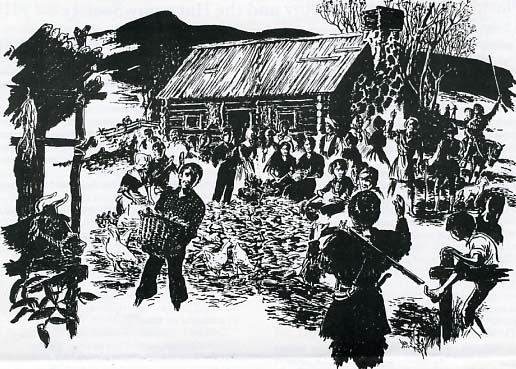
Click Here to Return to Milestones
Early pioneer life along the Ohio River valley (which was a section of America's first frontier) was for the most part, a rugged and trying existence. But people worked hard, and when it came time to play, they played hard. In the Fall, harvesting meant hard work. And, an extra bountiful harvest meant longer hours in the fields and barns. But reaping the rewards of a good year had an energizing effect on the community.
Ways were devised to combine practical skills into popular social events. Pie socials, shooting matches, etc. were great. But the Fall Husking Bee was something special. The rules were simple. The corn to be husked was put in two equal piles. Two captains chose teams and they raced to see who would be the first to remove all the husks.
We shall again draw upon the journal of Mr. John Mathews of Massachusetts - a nephew of General Putnam - (see Milestones, Summer 1990) for an eyewitness account of Fall on the Ohio River Valley frontier in 17861.
"Mathews and party went up the east bank of the river to McMahan's, and then to the house of William Greathouse, which they reached November 9th. November 10th they tarried and heard asermon from a Methodist minister, located at that early day on the bank of the Ohio, in Virginia 2. November 11th Mathews went to a Virginia 'corn-husking, at Harman Greathouse's, where a number of settlers had gatheredi n. They had rye whiskey in plenty, and, the husking being finished, they sang, danced, told stories, quarreled, and all who could walk went home about 10 o'clock in the night. Three, who were too drunk, remained over night, hugging the whisky bottle and arguing religion. Sunday, November 12 others came in and assisted in drinking up the whisky. November 22, General Tupper, the acting commissioner in General Putnam's absence, left for the east. November 23, Colonel Sprout and a Mr. Simpson left for the east, and the surveying party disbanded for the winter, Mathews remaining at Greathouse's, where the snow was two and a half feet deep on the 5th of December, 1786."
Again, quoting from Mathews'journal for June 1787... "23d. The troops fiom Fort McIntosh passed this place on their way down the river. The Indians have lately done mischief about ten miles above Wheeling; they have also been seen near here; and from many circumstances I fear the summer will be a troublesome one." On the 30th of July, Mathews was at Wheeling, and says on the 9th of that month he went to Pittsburgh, from whence he returned to McMahan's and spent eight or ten days with the surveyors, who, it seems, a part of them at least, had returned from the woods. While at Wheeling he notes in his journal: "The Indians have been seen in this quarter lately, and have stolen several horses. About ten days past, the signs of a party were discovered near Short creek, and where followed by a party of our people, who came up with them four miles below Wheeling - killed one and wounded two more of the Indians, who were eleven in number. Our party consisted of only eight men. The Indians were attacked unexpectedly in their camp, and fled with precipitation, leaving their blankets and moccasins behind them. It is supposed they were Chippewas. On the 31st he returned to McMahan's.
This may have been the final exodus of troops from Ft. McIntosh. With most of the Indian uprisings now further west, the frontier perimeter of the federal U.S. military gravitated from the county, following the surveyors - and providing them with needed protection.
